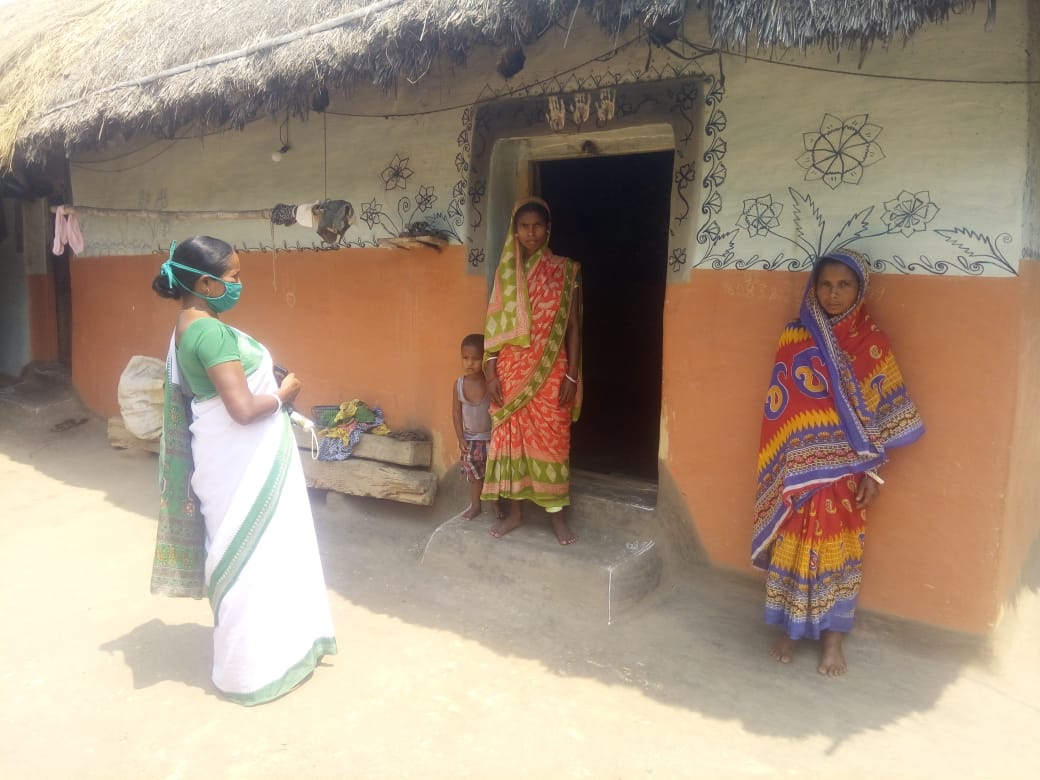What is going on in the villages of India at present? Who has cough, cold and fever in the village? How many people have come from other states in each village? Where are they kept? How many people have been tested for or been diagnosed with COVID-19?
If you need accurate information about all these questions, you should meet the foot army of the health department. This army is of more than one million women who bear the responsibility of India’s health system on their shoulders.
“We don’t have a single day off at this time. Our job is to go door-to-door to show them how to wash hands properly, to follow social distancing, and the benefits of wearing masks. In addition, a format has also been given to fill in which there are some questions regarding symptoms such as cold, cough, cold, fever and difficulty in breathing and whether someone has come from outside in the house. We fill up the form after seeking individual responses,” ASHA worker Rekha Jatav, 41, said.
Rekha is one of the million ASHA workers who are the vital backbone of the rural health system. Like Rekha, all ASHA workers in the country are currently relaying their village information in detail to the health department so that the viral infection does not affect more people. ASHA worker is the sole medium in conveying the news of the village to the health department.
The work of these ASHA workers may not be sensational to make news headlines but is praiseworthy nonetheless. It would have been challenging for the health department to identify people from outside without their help. They sleep for five to six hours, put their domestic chores in order and take to the streets of the village. They do not enter anyone’s house at this time. They call out people to see them outside and hear from them the benefits of washing hands regularly, standing at a proper distance and wearing masks.
There is an ASHA worker per one thousand people. In villages with a large population, these numbers increase. In some states, ASHA workers get a definite honorarium while in many places they are given incentive on the basis of their work. They are often underpaid for their responsibilities. The government has announced financial security for the ‘Corona Warriors’ standing at the forefront of the coronavirus battle. Finance Minister Nirmala Sitharaman has announced Rs 1.70 lakh crore, including Rs 50 lakh insurance for every health worker, medical staff, ASHA workers and safai karamcharis who are risking their lives to work during the deadly spread of coronavirus.
The importance of the role of ASHA workers at present can be gauged from the statement of Rahul Kumar, district magistrate of Purniya district of Bihar. “All the people who come from outside are in self-home quarantine, are fully supervised by ASHA bahus, Anganwadi and ANMs stationed in the village.”
It is not only Purniya district of Bihar but each village in every district of the country has ASHA performing her responsibility.
“We are also doing regular followups regarding where the people coming from outside in the village have been quarantined. We visit 30-35 houses every day. We inform people about their own protection and fill the format. The daily report also needs to be prepared and sent by ASHA worker,” Rekha informed. Rekha is an ASHA worker from Vinapur village in Bhopal City of Madhya Pradesh.
The most important role in the corona virus infection is that of ASHA workers at present. After the lockdown, millions of labourers who went to different states in search of employment years ago, have returned to their villages. These labourers have come from crowded places. As a precautionary measure, they have been quarantined for 14 days at panchayat bhawan and government schools. Some people are also self-quarantined in their homes. The complete information on these people is with the ASHA workers.
ASHA worker is the end link of the health department posted in the villages of India. They may not have got the status of a government servant but are important units of the health department. They have accurate knowledge of every family in their village because they reside in the same village. These ASHA workers are known in different states by different names, such as Asha bahu in Uttar Pradesh, Sahiya Didi in Jharkhand and Asha in Madhya Pradesh.
Whether the information of every household filled in the form by Rekha is correct and complete or not, is monitored by the ASHA aide posted in the same area. Under the supervision of an ASHA aide are up to 10-25 ASHA workers.
She said: “ASHAs are welcome right into the kitchen of every house in her village. It shows the level of confidence people of the village have upon them because they are educated women of the same village. The exact information of every household is available to us through ASHA, but still we go to monitor it so that nothing is amiss.”
She added: “Four jamaatis apprehended from the mosque in our own area were tested to be corona positive. Despite the prevailing atmosphere of fear, no ASHA has stopped in her work. Although we do not get the payment that our responsibilities deserve, they still are as resolute as ever, irrespective of any work coming their way.”
The National Rural Health Mission (NRHM) had created the post of ASHA workers (accredited social health worker) in the year 2005 to look after the health of rural women and children. As per the National Rural Health Mission (NRHM) data, the total number of ASHA workers in the country till September 2018 was about 10 lakh 31,751. It is the responsibility of the ASHA worker at the village level to look after pregnant women and newborns, to provide basic health facilties at door step besides deftly carrying out other additional responsibilities given by the health department from time to time. Depending upon the size of population, every district has 1000-2500 ASHA workers.
Meanwhile, more than 13 lakh people worldwide have been infected with the corona virus that the ASHA workers are working against and more than 73,000 people have died due to the same virus. The number of patients infected with this virus in India has exceeded 4,000. During the course of treatment, 325 people have been cured while 114 people have died.
These ASHA workers posted in the village have access to remote, inaccessible villages where people are often reluctant to go. Lali Gope is a sahiya didi (ASHA worker) of Haludabani village of Ghatila block in East Singhbhum district of Jharkhand where Sabar tribals dwell. These tribes are considered to be very backward, it is also difficult to make them aware, but Lali makes this difficult task a success every day.
“They feel that the government has imprisoned them in homes so that their land can be taken away from them. It is difficult to explain to them. They are very poor and it is not possible for them to repeatedly wash their hands with soap. They have to be told very often. Sometimes it takes a long time to convince a family but still I try calmly. I think who else will tell them if we don’t,” said Lali Gope, 38.
Lali Gope sends every day’s report of her work to an aide. Her aide, Bhasha Sharma, 40, said: “We have to go to the village every day to ensure that the information given us is correct and complete. Now, the heat has become overbearing but no one among us sits comfortably at this time. Every day, 40-50 houses are visited by a sahiya didi because these reports are sent across daily.” Bhasha Sharma is a resident of Jodisa village under whom are 18 sahiya didi (ASHA workers).
Uday Sharan Prasad, district programme coordinator of Chatra district of Jharkhand, said: “If it were not for ASHAs, the health department had no means to get information about the village at this hour of need. ASHA has to report every day as to how many houses she has been to, how many people from outside the state have come into the village? At present, we get all the information about those who have come from outside only from ASHA workers.”
Vivek Nawal Mishra, block community process manager, Lucknow’s Mall block, said: “At present, the COVID 19 survey is going on for a week, which is being conducted by ASHA bahus. Presently, there are two important responsibilities of ASHA — to make people aware and to keep an account of every person who comes from outside to the village.”
“If anyone of the villagers shows a little bit of cold, cold, fever, we immediately send them over to the community health centre for treatment,” ASHA Sangini Ranjana Dwivedi, 45, said.
ASHA is the frontline soldier of the health department who has always been active in the village informing people about malnutrition, immunization, sanitation management and meeting with adolescent girls. With so many charges, it is not unusual for an ASHA worker to spend several days on duty in the hospital and walk long distances on an empty stomach.


















